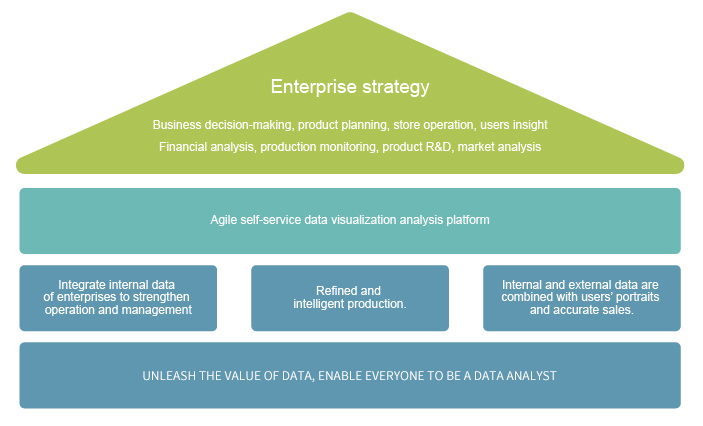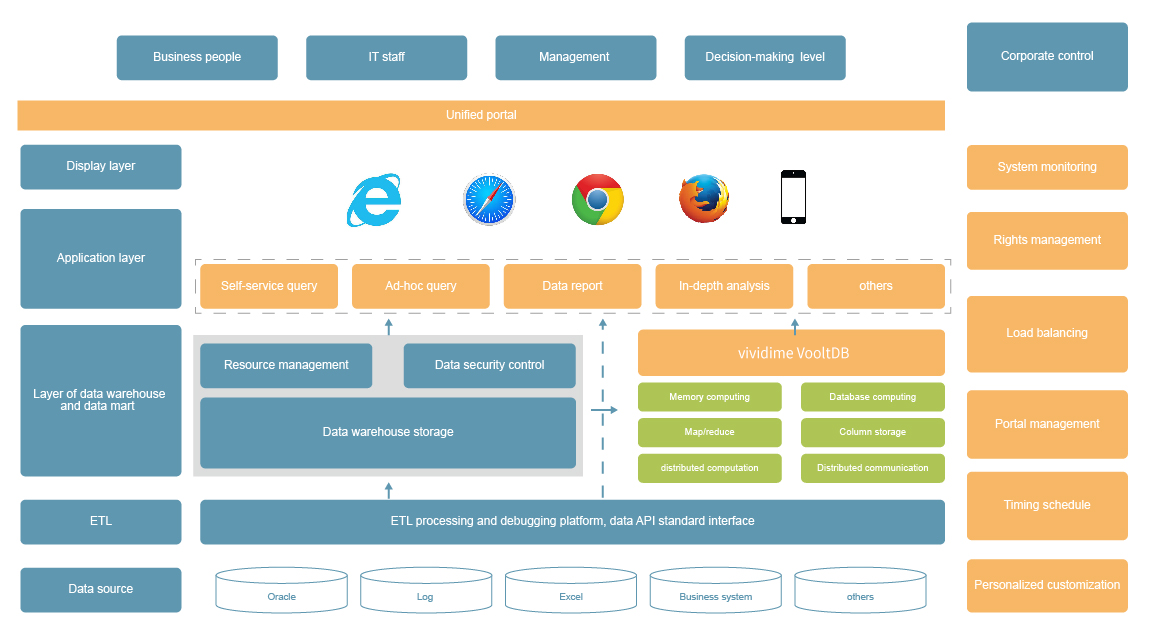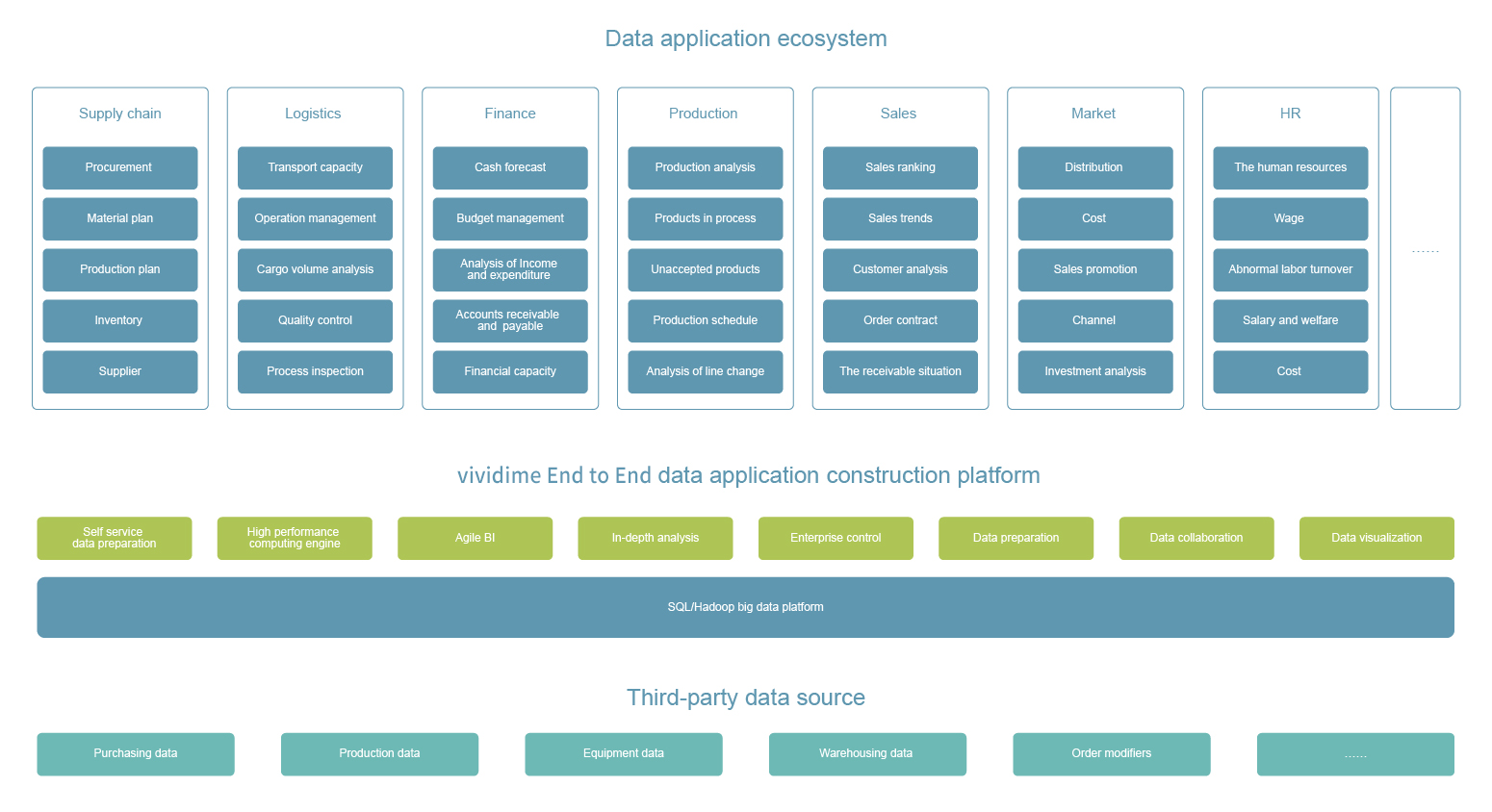
Industrial Internet is the Cornerstone and Big Data is the Engine
vividime's Solution for Manufacturing Industry
1.Extensive operations
Making decisions based on experience is a common problem in the manufacturing industry. Data are stored, but not used properly. Data should also be a part of decision making.
2.Data island
With the gradual improvement of information technology, financial information systems, MRP systems, ERP systems, etc. are gradually improving. However, there is a lack of a unified platform between internal information systems to associate, integrate, and connect data, resulting in the inability of various links such as production, sales, and inventory to work together, making it difficult to fully unleash the true value of data.
3.Lacking of data management
Although the enterprise has accumulated a certain amount of historical data, the lack of planning for data management in the early stage has led to uneven data quality, scattered data, and inconsistent basic data, making it difficult to provide support for upper level data statistical analysis applications.
4.Slow response for the need of data analysis
Users at different levels have completely different needs for data analysis, and currently manufacturing enterprises can provide analysis reports mainly in the form of tables, with a single analysis dimension, simple and rigid form, and poor timeliness in responding to analysis needs, which cannot meet users' fast, flexible and ever-changing data analysis needs.
5.High cost and risk of the data analysis system
For manufacturing enterprises, the bosses wants to use the least investment to have the largest effect as soon as possible. However, traditional big data platforms have high project costs, slow returns, and high risks. After a long period of data warehouse construction and modeling, they still cannot show the value that data brings to senior leaders. Therefore, many manufacturing companies hesitate to invest too much in this area.

1.Define strategic objectives
Strategic goals can be big or small, and departments and teams have their own goals. From the perspective of implementing big data projects, what is most important is to analyze and abstract goals in order to effectively apply data.
2.Building a Data Analysis Indicator System
Analysis indicators are the lubricant that connects business and raw data in the data-driven operation system. They are processed from raw data and in turn drive other data application products. Enterprises need to sort out business analysis indicators, establish a standard data analysis indicator system, clearly define the caliber and meaning of indicators, standardize the management of indicators, and ensure the consistency of data statistical caliber and accuracy of results.
3.Building a data analysis application
Build a standardized and intelligent data grading and application center in stages, providing corresponding data application services for personnel at different levels within the enterprise. This will not only provide digital decision support and risk monitoring for enterprise executives, but also meet the daily statistical and analytical needs of data analysts By streamlining reports and indicators, gradually transform management from data processing to data analysis.
4.Implementation Practice of Data Projects
In the construction of big data projects for manufacturing industry, it is necessary to proceed step by step and not be tempted by the big picture. In the process of project promotion, the value of data should be gradually released. For enterprises, they can set a grand blueprint for big data applications in the coming years, but they must pay attention to gradual and rapid decomposition during the implementation process. For internal big data project managers, risk management of enterprise big data projects is also essential.

Based on enterprise level end to end big data application construction platform, integrate internal and external data of the enterprise, strengthen the management of enterprise data assets, and achieve the connectivity of data in various fields. Business personnel use self-service data visualization analysis technology to explore the value of data, quickly build data applications, and achieve strategic goals in areas such as business decision-making, product development, store operations, finance, marketing, and production.
Data source layer
Integrate data from different business information systems and channels to achieve the correlation and integration of heterogeneous data sources.
vividime provides connection for all major data sources.
ETL layer
Define a unified data API standard interface for data cleaning, conversion, and loading operations.
vividime has self-service modeling for data cleaning, joining, and modeling by just using drag and drop operations.
Warehouse and marketing laye
Store the detailed data after ETL in a star or snowflake model in the data warehouse. According to the requirements of business analysis topics, divide the data model into topics and import them into the VooltDB data market for accelerated processing of operations.
VooltDB is a data engine designed by vividata just for BI, and it can provide sub-second computational responses for datasets spanning from tens to hundreds millions.
Application layer
Establish rich data application scenarios such as ad hoc queries, multidimensional analysis, data reporting, and in-depth analysis for business personnel at different levels and analysis topic need
vividime provides queries, reports, and analysis functions all in one platform.
Display layer
By presenting rich and beautiful charts and flexible interactive methods, the analysis results are presented to decision-makers, management, IT personnel, and business users. All users can access the system through mainstream browsers or mobile terminals.
vividime has more than 80 components of charts, tables, form filling tools, and etc. These can fulfill all the requirement of data analyzing.


1.The vividime end-to-end big data analysis platform greatly reduces the learning curve of data application construction, making building data applications a building block like experience. When manufacturing enterprises have rich applications and users, driving the value realization of business and management, data and underlying infrastructure are activated and become larger, forming a virtuous cycle and truly realizing the enormous value that data brings to enterprises.
2.vividime promotes the application of big data analysis technology within enterprises, help them to improve the accuracy and timeliness of data, enhance innovation in products and services, improve their business decision-making level, reduce operational risks, and increase the possibility of further exploration, discovery, and market segmentation.
3. It helps enterprises to establish a data operating system, and truly realize data-driven decision-making (decisions made through data are better than conventional decisions). Through the data operation, the business personnel transform the data into operational strategy, so as to judge the trend and carry out effective action, and help themselves to find problems and promote presentation of innovation or solution.